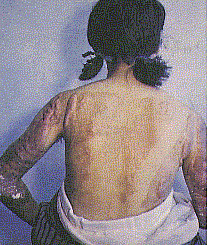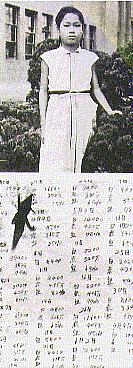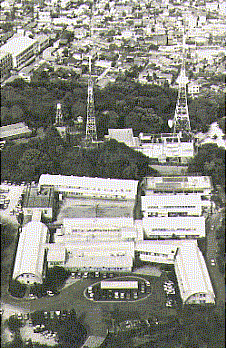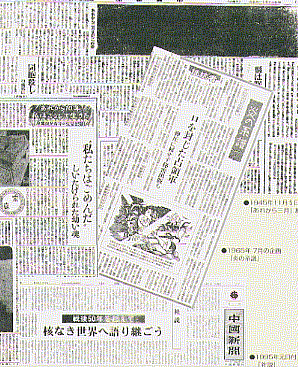
| 6. INVISIBLE EFFECTS OF A-BOMB |
Radiation is classified into two types: initial radiation which was released by atomic bomb within one minute of detonation, and residual radiation which was released after the initial radiation. Those who were exposed to radiation suffered long after the war was over. It took people a long time to recognize the invisible effects of A-bomb. Of the diseases caused by the A-bomb, a group of symptoms which appeared during the first four or five months after the explosion were called acute sickness or injuries, and symptoms that appeared after a certain incubation period were called aftereffects of radiation.
-Keloids-
After the burns and wounds of those injured by the A-bomb had once seemed to be healed, the scars became thick and produced growths known as Keloids. The keloids were seen in 50-60% of those exposed to thermal heat rays within 2 km from the hypocenter. Keloids are said to be associated with radiation. Keloids left permanent scars on the victims' mind and bodies. Those with keloids on their faces more suffered mentally and those with keloids on their backs and shoulders hesitated to show their skin. A lot of people in Hiroshima were seen wearing long-sleeve shirts even in the summer.
 |
| A woman with keloids on her back and arms (October, photographed by the U. S. Armed Forces) |
-Leukemia-
Leukemia is a malignancy of hematopoietic (blood-forming) cells, in which leukocytes greatly increase, causing loss of their normal functions and weaken immunity to infectious diseases. Although those who were not exposed to A-bomb can develop leukemia, the incidence of leukemia in Hiroshima and Nagasaki was found to be significantly high among those who had been closely exposed at a young age, and leukemia became to be widely recognized as a aftereffect caused by radiation.
Leukemia incidences peaked during the 1950's and was considered a typical atomic bomb disease and gave hibakusha a strong anxiety. Sadako Sasaki, a student of Noborimachi junior high school, suddenly developed leukemia and died at the age of 12 in the Hiroshima Red Cross Hospital on October 25, 1955. Her classmates erected a monument called the "Children's Peace Monument" for her and for all children who died as a result of the A-bomb.
 |
| Sadako Sasaki (above) and the note she wrote down her blood count in her sickbed.
|
-Prenatal Exposure-
In 1946, women who were exposed to radiation close to the hypocenter during pregnancy gave birth to babies with small heads. It was found as they grew up that most of them had severe mental retardation. This condition is termed "microcephaly." These disabilities happened when foetuses were exposed to radiation at a gestational age of 8-25 weeks (especially 8-15 weeks) because at this stage, the fetal cells are particularly sensitive to radiation. Those foetuses that were exposed to radiation within 2 km from the hypocenter and were born before May 31, 1946 are estimated to be 1,100.
-Cancer (malignant tumors)-
While occurrence of leukemia decreased during the 1960's, other tumors, such as thyroid cancer, breast cancer, lung cancer and salivary gland tumors began to occur among A-bomb survivors. It is a fact that radiation is one of the significant factors of inducing cancers, and the incidence of some cancers have a causal relationship to the distance from hypocenter and the radiation dose to which the survivor was exposed. Among the cancers which were confirmed to be related to radiation, there are some kinds which began to increase during 1955 to 1965 such as thyroid cancer, and there are other kinds which began to be remarkable only recently, such as colon cancer and myeloma. It is considered that the younger the age of the survivor at the time of exposure, the greater the risk of cancer.
-A-bomb Caused Cataracts-
Cataracts show symptoms of clouding of the lens and poor eyesight. They were identified for the first time in the autumn of 1948 in Hiroshima, and in June of 1949 in Nagasaki. Radiation-caused cataracts are different from those resulting from old age. The occurrence of atomic bomb cataracts and the degree of clouding of the lens are causally related to the radiation dose. It is considered that the closer the survivor was exposed to the A-bomb, the greater the risk of cataract.
[Genetic effect]
People have been anxious about the possibility of the genetic effects of radiation. Various research and studies have been conducted from different viewpoints by specialists, but any harmful effects on descendants of hibakusha have not been founded so far.
Medical Care for Atomic Bomb Victims
Fumio Shigeto, a deeply respected physician by hibakusha, retired as director of the Hiroshima Red Cross Hospital & Atomic-bomb Survivors Hospital in the spring of 1975, 30 years after the atomic bombing.
"A physician's duty is to keep patients alive as long as possible and improve their health as much as possible. It applies to A-bomb survivors as well. If there are diseases particular to hibakusha, we have to identify the cause of them and how to ease their pain. I hope that hibakusha will survive as long as possible and contribute to the happiness of their families and peace." These are the words Shigeto left to people.
Doctors in Hiroshima who supported "A-bomb medical treatment" devoted themselves to keeping hibakusha "alive". It is said that 225 doctors died by the A-bomb dropped on Hiroshima. They were also hibakusha. Doctors in Hiroshima promoted medical activities, cooperating with medical researchers throughout Japan including Masao Tsuzuki, a professor of Tokyo University, who has studied the condition of hibakusha since right after the A-bombing. Through these activities, many medical institutions have been established one after another, such as research councils of A-bomb aftereffects, health-maintenance centers, organizations for investigation and research, and hospitals specializing in A-bomb treatment with necessary facilities and medical equipment. These institutions have taken up the activities in which the medical experience of A-bomb treatments are used in order to help radiation victims throughout the world that have been harmed by the development of nuclear weapons, and accidents at nuclear power plants.
●Doctors in Hiroshima
It was Gensaku Oho, a physician, who found that the death rate of cancer of hibakusha was particularly high around 10 years after exposure. After returning to Hiroshima from his place of war-time refuge, Oho resumed examining hibakusha at the internal medical clinic in his half-destroyed house. Through the examination, he discovered that there was a high risk of leukemia and stomach cancer among hibakusha. Then he checked 11,400 of death certificates submitted to the Hiroshima municipal government between 1951 and 1955, and discovered statistically that cancer deaths among hibakusha were much higher than the national average. He published his research in a medical journal in 1956.
Medical study meetings and conferences were held by physicians and surgeons with the same aims as Oho. This promoted to an exchange of information and treatment of hibakusha.
●Hiroshima A-bomb Casualty Council
c/o Hiroshima Comprehensive Health Center
3-8-6 Senda-machi, Naka-ku, Hiroshima City 730
Tel: 082-243-2451
In order to promote an organized medical system, the Hiroshima A-bomb Casualty Council was established in January 1953 with the cooperation of the Hiroshima municipal government and Medical Association. They started jointly examining hibakusha and studied their actual conditions. Women with keloids were sent to America for treatment in 1955 under the cooperation of the Hiroshima A-bomb Casualty Council. It became a foundation and was given its current name in 1956. The examination of hibakusha is conducted in the Health Management and Promotion Center, which is a part of the Hiroshima A-bomb Casualty Council.
●Radiation Effects Research Foundation (RERF)
5-2 Hijiyama-koen, Minami-ku, Hiroshima City 732
Tel: 082-261-3131
The RERF originally began as the Atomic bomb Casualty Commission (ABCC), a U. S. medical research center for A-bomb effects in 1947. The U. S. run Japanese organizations were established both in Hiroshima and Nagasaki in 1948. The current building was completed in 1950. Research on epidemiology in relation to life spans of 120,000 hibakusha, and health conditions of 20,000 of those hibakusha has been continuing for many years. The ABCC was criticized as having been only for research and not for treatment of patients. In 1975, it became a jointly run foundation by both the U. S. and Japan, and was given its current name. The data on the health of hibakusha that the RERF has collected is very valuable. Several issues are being discussed between both countries, such as moving the building to another location in the city, and changing the U. S. department in charge of operating the RERF.
 |
| Radiation Effects Research Foundation in Hijiyama Park (former ABCC) |
●Research Institute for Radiation Biology and Medicine
1-2-3 Kasumi-cho, Minami-ku, Hiroshima City 734
Tel: 082-257-5555
This institute was founded in 1961. There are four research divisions; the Division of Environmental Biology, the Division of Molecular Biology, the Division of Social Medicine and the Division of Clinical Research. Apart from its research on the aftereffects of A-bomb radiation, it has been researching the social condition of hibakusha. Together with the RERF, the Institute takes an active role in promoting medical cooperation with foreign countries, as shown in the recent treatment of the victims of the Chernobyl accident.
●Hiroshima Red Cross Hospital & Atomic-bomb Survivors Hospital
1-9-6 Senda-machi, Naka-ku, Hiroshima City 730
Tel: 082-241-3111
The Atomic-bomb Survivors Hospital has been relied on most by hibakusha for its relief activities and treatment of aftereffects. It was established in 1956, in conjunction with the Hiroshima Red Cross Hospital. In 1988, the two hospitals were combined and since then, the Atomic-bomb Survivors Hospital has specialized in the treatment of A-bomb sufferers. From 1956 until the end of March 1994, some 80,000 patients received treatment. In 1993, an average of 77 patients a day were hospitalized in the internal department and 36 a day in the surgical department. 2,584 of the hospitalized patients died in 38 years since the establishment of the hospital. Gastric cancer is ranked as the highest cause of death, followed by lung cancer, then liver cancer. 109 leukemia victims died.
[Medical Cooperation for Radiation Victims Throughout the World]
Throughout the world, there are a number of radiation victims from nuclear power plant accidents, nuclear weapons production, and nuclear testing. In order to save these sufferers, the Hiroshima International Council for Health Care of the Radiation-Exposed (HICARE) was established in 1991. The prefectural government, the municipal government, medical associations, the Research Institute for Radiation Biology and Medicine, the RERF, the Hiroshima A-bomb Casualty Council, the Hiroshima Red Cross Hospital & Atomic -bomb Survivors Hospital, and others take part in the council. Making the most of the experience of treating A-bomb victims, the council's activities include dispatching doctors to foreign countries and accepting foreign doctors for training.
Handing Down "Hiroshima" to Each Generation
A number of people have been dedicated to educating the world about the disasters of A-bomb in diversified ways, from testimonies of hibakusha themselves, newspapers and news photos to radio and television and novels, children's stories. Paintings, sculptures, movies, animation, plays, music and dancing also served to convey thoughts and feelings about the atomic bombing and the search for an enduring peace.
Some are internationally recognized as pieces of art, others are produced by unknown people such as notes by children in Hiroshima or plays by high school students in the attempt to inherit the experience of Hiroshima. These people have been appealing to younger generation and people of the world that we should look straight at the experience of Hiroshima and Nagasaki to share and deepen the understanding of the damages nuclear weapons bring about.
-Silence and Screams-
Right after the A-bombing, hibakusha thought that the terrible sight was far beyond description. It was such a tragedy in reality. 'Natsu no Hana' (Summer Flowers) by Tamiki Hara was written in 1947 in the midst of indescribable misery.
However, as time went on, it came to be considered that telling the truth would make people of the world know the absurdity and fear of nuclear weapons and help promote the establishment of peace in the world. A collected account of the bombing by the children of Hiroshima, 'Genbaku no ko' (Children of the Atomic Bomb) was edited by Arata Osada in 1951. This story was later filmed by Kaneto Shindo in 1952. Genbaku Shishu (Collected A-bomb Poems), which begins with the famous opening phrase; "Give back the human race" was written by Sankichi Toge in 1951.
Nobel prize winner, Kenzaburo Oe wrote in 1965 'Hiroshima Notes,' an essay in which the author introduces those he meets in Hiroshima. Masuji Ibuse wrote a novel, Black Rain in 1966 during the Vietnam War and passed on the deep meanings of people's experiences. This novel was filmed later by Shohei Imamura in 1989.
In 1950, Iri and Toshi Maruki produced the first mural, a series of visual testaments of the A-bomb experience titled 'Genbaku no Zu' (A-bomb Murals). Ikuo Hirayama painted Genbaku Seihenzu in 1974, where he depicted the city consumed by flames. In 1974, Unforgettable Fire, a collection of pictures painted by hibakusha was published by the Japanese Broadcasting Corporation (NHK) and a collection of A-bomb photographs was also published in 1987.
The author of Hiroshima (1946), John Hersey, is one of many non-Japanese journalists and scholars who committed themselves to recording the experience of the A-bombing. Testimonies of hibakusha are still widely collected through hibakusha organizations. All these activities are efforts to share the A-bomb experience with many people as a common experience of humanity living in a nuclear age.

Informative Reporting
The Chugoku Shimbun wrote some 80,000 of articles related to the A-bomb, nuclear weapons, peace movements, and hibakusha relief activities between 1945 and 1995. With the establishment of a database made up of these articles, Hiroshima Chronology: a Record of the 50 Years of the Nuclear Age was published in order to provide those who want to know about the A-bomb, nuclear weapons, peace movements and hibakusha relief activities with the precise information.




